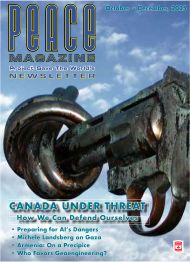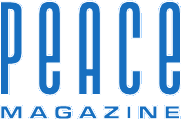Michele Landsberg became a Zionist at age 13. Much later, appalled by Israel’s war crimes in Gaza, she became leader of Women in Black, a gathering of protesters who nowadays vigil on the streets in Toronto and several other Canadian cities against Israel’s war on Gaza.
For over half a century, Michele Landsberg’s name has been synonymous with fearless journalism, feminist advocacy, and unflinching social commentary in Canada. Yet in a recent candid conversation with Project Save the World’s president, Metta Spencer and her friend Jill Carr-Harris, Landsberg peeled back layers of her storied life to reveal a deeply personal narrative—one shaped by childhood trauma, ideological evolution, and an unyielding quest for justice.
The discussion, tinged with historical resonance and contemporary urgency, traced Landsberg’s transformation from a frightened Jewish child in 1940s Toronto to a “post-Zionist” grappling with the complexities of identity and belonging.
A CHILDHOOD UNDER SIEGE
Born in 1939, Landsberg’s early years unfolded against the backdrop of global upheaval. While World War II raged overseas, a quieter but insidious war played out in her Toronto neighborhood. “AntiSemitism was a daily force,” she recalled, describing a world where Jewish identity was met with hostility even in public schools. “instructing her class to pray for the salvation of “heathen” Jewish students”
One memory stood out: a substitute teacher in Grade Two instructing her class to pray for the salvation of “heathen” Jewish students. “We were threatened with the strap if we wouldn’t swear to pray to Jesus,” Landsberg said, her voice still carrying the weight of that humiliation.
Her parents navigated their Jewishness with caution. Her mother kept the Hanukkah candles in the kitchen instead of the window, and once nervously identified their family as “of the mosaic persuasion” during a school registration a euphemism that baffled young Michele.
Her father, ever the iconoclast, taught her subversive lyrics to Christian hymns as an act of quiet rebellion. “Jesus loves me, this I know? Very kind of Jesus!” she sang under her breath, evading detection. These moments of defiance,however small, planted early seeds of resistance.
ZIONISM AS SALVATION
By her teens, Landsberg’s isolation in predominantly non-Jewish suburbs left her “thirsting for belonging.” At 13, a chance invitation to a Jewish youth group downtown became a lifeline. Surrounded by peers debating philosophy and politics, she found intellectual kinship and a compelling narrative: Zionism.she found intellectual kinship and a compelling narrative: Zionism “The idea of a homeland where we’d be safe—it felt like salvation,” she admitted. In the shadow of the Holocaust, which her parents rarely discussed, the promise of Israel offered both refuge and purpose.
This phase of her life, however, collided with systemic barriers. Applying to graduate school in English literature, Landsberg faced a dean whose disdain for women and Jews was hardly veiled. “He told me, ‘the only reason you would go to graduate school is to teach English at the University of Toronto,’ which, of course, was the finest English Literature Department. And he said, ‘but no woman will ever be allowed to teach here. No woman has been allowed so long as I’ve been dean, and no woman ever shall be allowed so long as I’m here.’ That was right; no woman ever did get to teach English while he was there. I walked out of his office burning with humiliation, because there was no feminist movement.” The rejection stung, but it steeled her resolve. Journalism, not academia, became her battleground.
Metta Spencer and Jill CarrHarris both commented on the extreme disparity between the numerous occasions of anti-Semitism that had wounded Landsberg and the far friendlier tone that prevailed in academia later.
Jill said that in her school years, relations with Jewish classmates seemed entirely integrated. Likewise, Metta reported not having seen any expression of anti-Semitism whatever among university students when she was a professor, though she had observed discrimination against Pakistanis and Chinese foreign students. She believes that the current accusations of antiSemitism in universities are mostly invented for use as political weapons. Educated people, Spencer said, don’t confuse anti-Israeli politics and antiSemitism.“The idea of a homeland where we’d be safe–it felt like salvation”.
Michele Landsberg mostly concurred, though she remains keenly concerned about the lingering presence of anti-Semitism in many sectors of current society.
THE SOCIALIST LEWIS FAMILY
The rest of Michele Landsberg’s family has always been less enthusiastic about Zionism than she herself. Her husband Stephen Lewis’s background was that of Bundist socialism. His own father, David Lewis, immigrated to Canada at a young age and joined the CCF, the socialist movement that became, under his leadership, the New Democratic Party.“Naomi… argued that Israel was not a place of safety for Jews but instead was endangering them all”.
Stephen and their son and daughters have all remained more oriented toward social justice in Canada than aspiring for the future of a Jewish homeland. And shortly after son Avi married the writer Naomi Klein, Michele had an all-night-long argument with her brilliant new daughter-in-law, who argued that Israel was not a place of safety for Jews but instead was endangering them all.
THE UNMASKING OF “POLITE” PREJUDICE
As Canada’s post-war society reckoned with its complicity in the Holocaust—famously summarized by the government’s “none is too many” response to Jewish refugees—overt anti-Semitism waned, but subtle biases persisted.
Landsberg, by then a rising star columnist at The Globe and Mail, encountered quieter forms of antiSemitism. “I didn’t always recognize it at first,” she admitted.
Her feminist awakening in the 1970s sharpened her lens. Covering the women’s movement, she drew parallels between gendered oppression and the Othering of Jews.
“Both demanded you shrink parts of yourself to fit in,” she observed. Yet even within progressive circles, blind spots remained.
THE POST-ZIONIST RECKONING
The turning point came gradually. “I couldn’t reconcile the ideals I’d been taught with the reality,” Landsberg explained. Living in New York as the wife of Canada’s ambassador to the United Nations, she formed warm friendships with other prominent Jewish women who were critical of Israel, including Bella Abzug and Gloria Steinem.
Witnessing Israel’s occupation policies and the rise of right-wing nationalism, she painfully distanced herself from institutional Zionism and came to call herself a “postZionist.”
This shift drew criticism from former allies, yet Landsberg remained undeterred. As her activism expanded in response to the current war crimes in Gaza, she decided to revive a global vigil movement called Women in Black, which had begun by opposing militarism and occupation.
At one such recent street demonstration in Toronto she met Jill Carr-Harris, Spencer’s friend and cohost a serendipitous link underscoring the intergenerational nature of advocacy.
The conversation included Spencer’s early mention of Landsberg’s son, Avi Lewis, whose bid for the federal NDP leadership continues his family’s tradition of progressive politics. “He’s running in a difficult time,” Michele acknowledged, referencing the rise of right-wing populism. Yet her pride was palpable.“Even within progressive circles blind spots remained”.
REFLECTIONS ON A LIFE UNSILENCED
At 86, Landsberg’s fire hasn’t dimmed. She speaks of her journey not as a linear path but a series of reckonings.
In an era of fractured identities and escalating crises, Landsberg’s odyssey—from hiding candles to holding placards on Toronto’s streets—challenges us to confront uncomfortable truths. Her life is a tapestry of courage and contradiction. For her interlocutors Metta Spencer and Jill Carr-Harris, the exchange was a masterclass in resilience.



